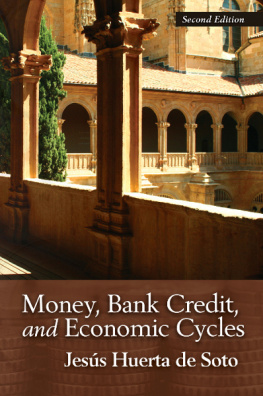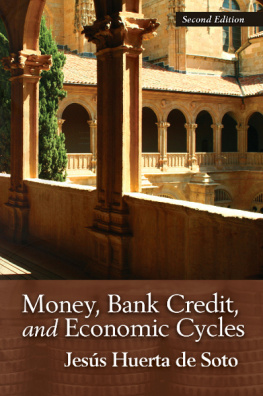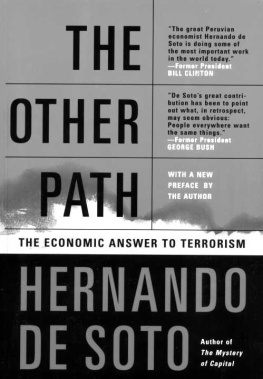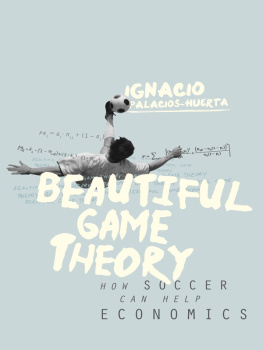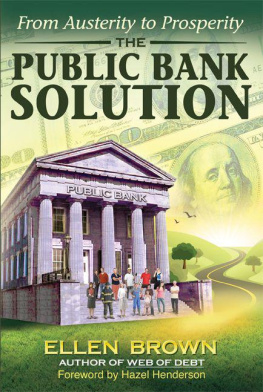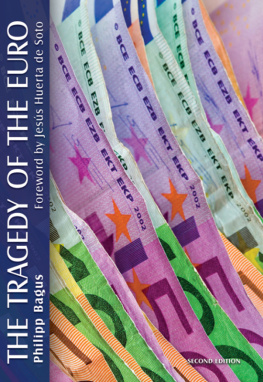Jesús Huerta de Soto - Money, Bank Credit, and Economic Cycles
Here you can read online Jesús Huerta de Soto - Money, Bank Credit, and Economic Cycles full text of the book (entire story) in english for free. Download pdf and epub, get meaning, cover and reviews about this ebook. genre: Science. Description of the work, (preface) as well as reviews are available. Best literature library LitArk.com created for fans of good reading and offers a wide selection of genres:
Romance novel
Science fiction
Adventure
Detective
Science
History
Home and family
Prose
Art
Politics
Computer
Non-fiction
Religion
Business
Children
Humor
Choose a favorite category and find really read worthwhile books. Enjoy immersion in the world of imagination, feel the emotions of the characters or learn something new for yourself, make an fascinating discovery.
- Book:Money, Bank Credit, and Economic Cycles
- Author:
- Genre:
- Rating:5 / 5
- Favourites:Add to favourites
- Your mark:
- 100
- 1
- 2
- 3
- 4
- 5
Money, Bank Credit, and Economic Cycles: summary, description and annotation
We offer to read an annotation, description, summary or preface (depends on what the author of the book "Money, Bank Credit, and Economic Cycles" wrote himself). If you haven't found the necessary information about the book — write in the comments, we will try to find it.
Money, Bank Credit, and Economic Cycles — read online for free the complete book (whole text) full work
Below is the text of the book, divided by pages. System saving the place of the last page read, allows you to conveniently read the book "Money, Bank Credit, and Economic Cycles" online for free, without having to search again every time where you left off. Put a bookmark, and you can go to the page where you finished reading at any time.
Font size:
Interval:
Bookmark:
BANK CREDIT,
AND
ECONOMIC CYCLES
TRANSLATED BY MELINDA A. STROUP

First Spanish edition 1998, Dinero, Crdito Bancario y Ciclos Econmicos, Unin Editorial, Madrid
Copyright 1998 Jess Huerta de Soto
Second Spanish edition 2002, Unin Editorial, Madrid
Copyright 2006 Jess Huerta de Soto
Translated from Spanish by Melinda A. Stroup
First English edition 2006, Money, Bank Credit, and Economic Cycles, Ludwig von Mises Institute, 518 West Magnolia Avenue, Auburn, Alabama 63832-4528
All rights reserved. Written permission must be secured from the publisher to use or reproduce any part of this book, except for brief quotations in critical reviews or articles.
ISBN: 0-945466-39-4
ISBN: 978-0-945466-39-0
It is a genuine pleasure for me to see this handsomely-printed English edition of my book, Dinero, Crdito Bancario y Ciclos Econmicos, which first appeared in Spain in 1998. This translation incorporates the small number of corrections included in the second Spanish edition of January 2002, and it is the result of the great effort of Melinda A. Stroup, who wrote the first English manuscript of the entire book.
This English version was thoroughly examined by Dr. Jrg Guido Hlsmann, whose comments on several important points improved the manuscript significantly. I would also like to acknowledge the work of my research assistant, Gabriel Calzada, who searched for various English editions of rare books unavailable in Spain and looked up certain quotations and references. Last, I personally inspected the final version in its entirety to ensure the accuracy of its content.
I am grateful to the Ludwig von Mises Institute, and especially to its president, Lewellyn H. Rockwell, Jr., for bringing the project to its culmination with such high standards.
Jess Huerta de Soto
Seoro de Sarra
May 2005
________________
Note: The author welcomes any comments on this English-language edition and requests they be sent to
Following the success of the first edition of Dinero, Crdito Bancario y Ciclos Econmicos, which sold out rapidly, I am pleased to present the second edition to Spanish-speaking readers. To avoid confusion and facilitate the work of scholars and researchers, the contents, structure, and page numbering of the first edition have been maintained in the second, though the book has been thoroughly examined and all misprints detected have been eliminated.
In the wake of a decade marked by great credit expansion and the development of a large financial bubble, the course of economic events in the world from 1999 through 2001 was characterized by the collapse of stock-market values and the emergence of a recession which now simultaneously grips the United States, Europe, and Japan. These circumstances have left the analysis presented in this book even more clearly and fully illustrated than when it was first published, at the end of 1998. While governments and central banks have reacted to the terrorist attack on New York's World Trade Center by manipulating interest rates, reducing them to historically low levels (1 percent in the United States, 0.15 percent in Japan and 2 percent in Europe), the massive expansion of fiduciary media injected into the system will not only prolong and hinder the necessary streamlining of the real productive structure, but may also lead to dangerous stagflation. In light of these worrisome economic conditions, which have repeated themselves since the emergence of the current banking system, I fervently hope the analysis this book contains will help the reader to understand and interpret the phenomena which surround him and will exert a positive influence on public opinion, my university colleagues and economic-policy authorities in government and central banks.
Various reviews of this book's first edition have appeared, and I am grateful to the eminent authors of them for their many positive comments. A common denominator among all has been to urge the translation of this book into English, a task now complete. It is my hope that, God willing, the first English edition of this book will soon be published in the United States and will thus become available to some of the most influential academic and political circles.
Finally, over the past several academic years, this manual has been employed successfully as a textbook during the semester devoted to the theory of money, banking, and business cycles in courses on Political Economy and in Introduction to Economics, first at the law school of Madrid's Universidad Complutense and later at the school of law and social sciences of the Universidad Rey Juan Carlos, also in Madrid. This educational experience has been based on an institutional and decidedly multidisciplinary approach to economic theory, and I believe this method can be easily and successfully applied to any other course connected with banking theory (Economic Policy, Macroeconomics, Monetary and Financial Theory, etc.). This experience would not have been possible without the keen interest and enthusiasm hundreds of students have expressed as they studied and discussed the teachings contained in the present volume. This book, to which they have dedicated their efforts, is chiefly aimed at them, and I thank all of them. May they continue to cultivate their critical spirit and intellectual curiosity as they progress to higher and increasingly enriching stages in their formative journey.
Jess Huerta de Soto
Madrid
December 6, 2001
The economic analysis of juridical institutions has come to the fore in recent years and promises to become one of the most fruitful spheres of economics. Much of the work completed thus far has been strongly influenced by traditional neoclassical assumptions, namely by the concept of strict maximization in contexts of equilibrium. Still, economic analyses of law reveal the shortcomings of the traditional approach and do so perhaps better than any other branch of economics. In fact, juridical institutions are so intimately involved in daily life that it is notoriously difficult to apply the traditional assumptions of economic analysis to them. I have already attempted elsewhere to expose the dangers the neoclassical perspective brings to the analysis of juridical institutions. Economic analyses of law are certainly necessary, but they call for a less restrictive methodology than has generally been used to date, one more suited to this particular field of research. The subjectivist view is a more fitting approach. Developed by the Austrian School, it is based on their concept of creative human action or entrepreneurial activity and implies a dynamic analysis of the general processes of social interaction. This perspective promises to make great contributions to the future development of the economic analysis of juridical institutions.
In addition, most studies of juridical institutions carried out so far have had exclusively microeconomic implications because, among other reasons, theorists have simply borrowed the traditional analytical tools of neoclassical microeconomics and applied them to the analysis of law. This has been the case, for example, with respect to the economic analysis of contracts and civil liability, bankruptcy law, the family, and even criminal law and justice. Very few economic analyses of law have had mainly macroeconomic implications, and this reflects the harmful decades-long separation between these two sides of economics. However, this need not be the case. It is necessary to recognize economics as a unified whole, where macroeconomic elements are firmly rooted in their microeconomic foundations. In addition, I will attempt to demonstrate that the economic analysis of some juridical institutions yields critical implications and conclusions that are essentially macroeconomic. Or, in other words, even when the basic analysis is microeconomic, the conclusions drawn and primary outcomes resulting from it are macroeconomic. By closing the profound artificial gap between micro and macroeconomics, we arrive at a unified theoretical treatment of legal issues in the economic analysis of law.
Font size:
Interval:
Bookmark:
Similar books «Money, Bank Credit, and Economic Cycles»
Look at similar books to Money, Bank Credit, and Economic Cycles. We have selected literature similar in name and meaning in the hope of providing readers with more options to find new, interesting, not yet read works.
Discussion, reviews of the book Money, Bank Credit, and Economic Cycles and just readers' own opinions. Leave your comments, write what you think about the work, its meaning or the main characters. Specify what exactly you liked and what you didn't like, and why you think so.

